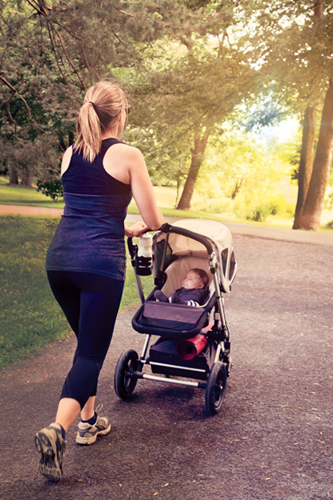Make a move
Your mantra through any postbaby exercises should be this: slow […]
Your mantra through any postbaby exercises should be this: slow and steady. The last thing you want is to push yourself too hard, too fast. Remember, it took months (10 if you’re counting) for your body to grow and change into what it is today. Whether you’re striving to get back to your prepregnancy weight or you just want to tone up your former bump, it will take time, and that’s OK. There are no winners or losers because there’s not even a race.
At your six-week postpartum appointment, your doctor will likely green light your return to the gym (or whatever your former fitness routine might have been). With the exception of a light walk around the neighborhood, you shouldn’t be lacing up your running shoes before you get that thumbs-up, says Kayla Itsines, personal trainer in Adelaide, South Australia, and creator of the Kayla Itsines Bikini Body Training Guide.

“If you’ve recently given birth, it is important to remember that your body has gone and is still going through massive changes,” says Itsines. Those changes affect your hormones, posture, appearance and sleep patterns—not just the number you see on the bathroom scale.
When you’ve gotten the good-to-go from doc, start by making small changes. According to Noell Yanik, exercise and health specialist and mom of two in Fort Mill, South Carolina, the first few months are all about walking and restoring your pelvic floor and core muscles.
Itsines says the best exercise to start will be going outside and getting some fresh air. Try putting your new bub in a stroller or carrier and going for a walk down the street. “Until you get used to how the pram works … or how your body feels moving it around, I suggest taking baby steps.”
As you set out on a stroll, aim for short distances at first. Over time, you can go for longer stretches. Eventually, when you feel your body is ready, you can take it up a notch with some light jogging.
Target practice
Lots of mamas wonder what they can do to target the areas most affected by having a baby. (We’re looking at you, belly and thighs.) But, truth be told, there’s no quick fix.
“This is a question many new mums ask me. Unfortunately, spot reduction—or target weight loss—is not possible. This is because in order to achieve a toned tummy or leaner legs, your body needs to lose body fat and gain lean muscle overall,” explains Itsines. “Your body works as a whole, and just like we can’t pick and choose where the fat goes, we can’t pick and choose where it comes off, either.”
So what can you do? Focus on health and fitness on a broad scale instead of doing as many crunches as possible in a day. Work up a sweat at least three to four days each week, and try to balance your cardio (walking, swimming, biking) with weight training.
For those who want to lose excess fat, Itsines recommends LISS—or low intensity steady state—because walking burns the most fat per calorie when compared to jogging or sprinting. Don’t let the superwoman on the treadmill next to you get you down. Slow and steady, remember?
Yanik urges those wary of the free-weights rack to branch out beyond their elliptical routine. “Lifting heavy weights will help create full-body tightness,” she says. And Itsines is clear that there’s no reason to fear weights will lead to bulking up. Walking might burn more calories per minute, she says, but resistance training continues to burn calories after your workout—even if you’re just cuddling your babe on the couch.
Last but not least, both Itsines and Yanik stress the importance of piling your plate with fresh, colorful foods. (What you eat plays a major role in tummy-toning!) As Yanik notes, “Fish, nuts, berries, green veggies—these are all foods that trim up those trouble areas if you fill your diet with them.”
Goal-oriented
As you stick with your workouts, you’ll notice changes gradually. But even if you get down to your prebaby weight, your clothes might fit differently. Your body will never be exactly as it was before it grew a human. Keep your goals realistic, and learn to appreciate your body for the amazing work it did and is still doing.
“I don’t recommend using a scale as the only way of tracking your progress,” notes Itsines. “Instead, try taking progress photos.”
If your best friend lost her baby weight in no time and you’re struggling early on, don’t let it get you down. Differences depend on the individual—not the exercises they complete, says Itsines. “Whether it’s a yoga class with your baby, walking around the block or beginning pretraining from my training guide, I suggest finding a form of exercise that you enjoy and getting back into it slowly and consistently.”







